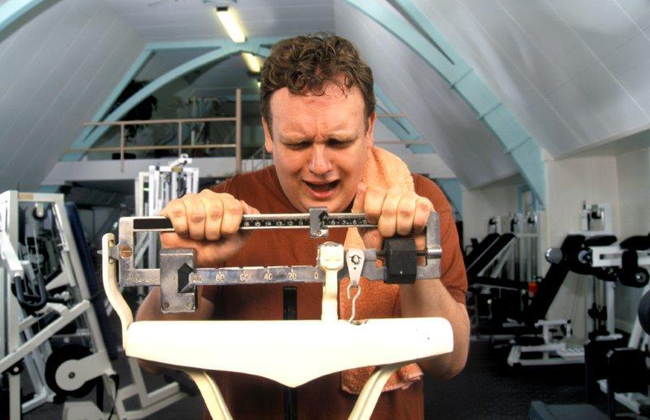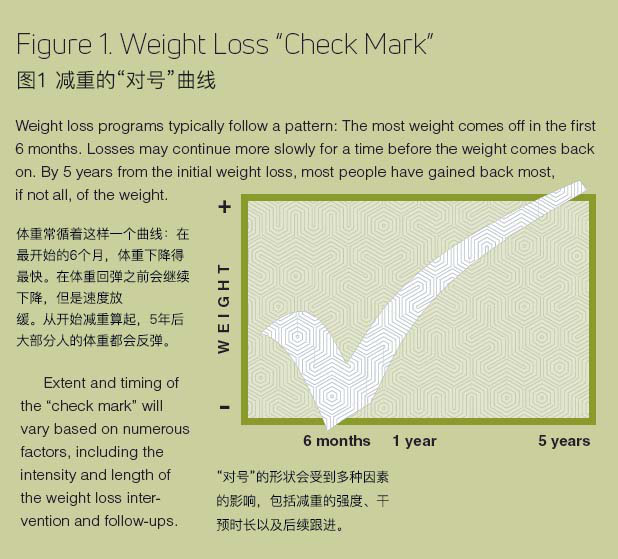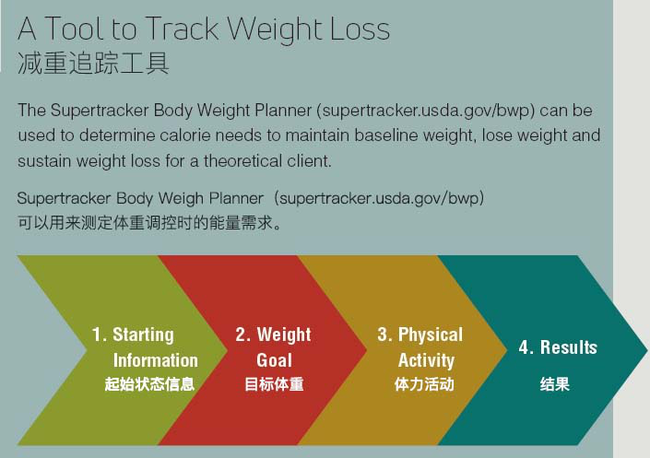体重的调定点
Understanding Set-Point Weight
我们很难准确地解释减重和保持体重背后的原理。为什么减掉的体重总是会反弹?读了本文,你就明白。
Finding the right words to clearly explain the complicated science of weight loss and maintenance can be tricky。 Use these ideas to educate clients—and yourself—on why lost pounds keep coming back。

人类有自己固有的一套模式来对抗节食。科学家发现:如果没有长期的体重维持规划,已经减掉的10%甚至更多的体重会在5年以内反弹回来。(Montesi et al。 2016)
Humans are hardwired to resist dietary restrictions。 Science bears this out: In the absence of an ongoing weight maintenance program, half of the people who lose 10% or more of body weight gain it all back within 5 years or so (Montesi et al。 2016)。
人们过去常常将这一现象归因于懒惰或者缺乏饮食原则,然而这一解释并不适用于所有人。越来越多的证据显示我们的身体会毫不留情地“调整”体重的过度减少,并回到我们的“初始”体重。体重调定点的科学机制告诉我们,要将焦点从减轻体重值转移到更健康的生活方式以及体重的维持上面去。
It used to be easy to blame this phenomenon on laziness or lack of dietary discipline。 But that explanation isn’t persuasive anymore because of growing evidence that our bodies have a relentless drive to “correct” excessive weight loss and return to a “set-point” weight。 Indeed, the science of set-point weight suggests we may need to shift our focus away from weight loss and toward healthier living and weight maintenance over time。
什么是体重调定点?它对我们的健康及减重来说有什么影响?作为健身行业人员,我们要能够向客户解释清楚这些问题。关于体重调定点,你需要明白:
Fitness professionals can play a pivotal role in educating clients about set-point weight and its effect on wellness and weight loss。 To make this happen, you must understand
- 人体对节食是如何应答的;
- how the human body responds to dietary restrictions;
- 为什么身体会自然地回到调定点体重;
- why the body naturally reverts to a set-point weight; and
- 如何说服客户改变他们关于减重的观念。
- how to convince clients to shift their perceptions on weight loss。
了解体重调定点这一概念,是帮助客户摆脱体重总是反复反弹这一怪圈的第一步。
Educating yourself on set-point weight is the first step toward helping your clients escape the seemingly never- ending cycle of losing and regaining weight。
- 当我们节食时,发生了什么?
What Happens When We Diet
那句广为流传的减肥口号——“管住嘴,迈开腿”——其实是对减重的一个误导,它并没有考虑体重调定点这个因素。看看它把减重这件事儿说得有多简单吧:
The persistence of the simplistic “eat less, move more” weight loss mantra is a nagging reminder of widespread misconceptions about the realities of set-point weight。 Consider how much this advice exaggerates the ease of weight loss:
燃烧额外的3500卡路里的能量会减轻1磅(约0.9斤)的体重,1年就可能减轻52磅(约47.2斤)的体重,这是一个很惊人的重量。而要实现它只需要每天形成500卡路里的能量缺口就行,比如在运动上多消耗250卡路里,在饮食上少摄入250卡路里。
Supposedly, burning an extra 3,500 calories will trim 1 pound of body weight—potentially yielding a whopping 52-pound weight loss in a year。 All it takes is a 500-calorie deficit every day—250 more calories of exercise and 250 fewer calories of food, for instance。
然而这只是理想状态,现实生活中很难实现。这方法在一开始时当然会很有效果,特别在减重最初的6个月内,制造能量缺口会使体重以肉眼可见的速度下降。之后,不管人们如何坚持他们的“健康的”生活习惯,总会发生一些变数。
Yet somehow this math never seems to translate to real life。 Sure, it may work at first。 Consistent attention to creating a calorie deficit can make weight seem to peel away—especially over the first 6 months。 But then something changes, no matter how well people stick to their new habits。
体重开始慢慢地反弹,这就形成了我们在相关研究和客户体重记录中常常能看到的 “体重对号曲线”(见图1)。
The weight starts to slowly (then not so slowly) creep back on。 This creates the classic “weight loss check mark” (see Figure 1) we so often see in research studies and in our clients’ weight loss journeys。
我们并没有了解体重调定点的全部,但我们知道在饮食不足或者饮食过量的状态下,我们的身体会触发一系列代谢及内分泌改变机制,进而影响体重的维持。知道了这一机制,有助于我们向客户传递体重调定点这一概念,从而让他们更好地知道怎么实现减轻体重、维持体重。
We don’t know everything about set-point weight, but we do know that habitual under- or overfeeding triggers metabolic and hormonal changes that have a profound influence on dieters’ ability to keep weight off。 When you understand how these mechanisms work, it will be easier to convey the concept to your clients, thus giving them a better chance to comprehend the realities of their lifelong weight loss and weight maintenance journey。

- 为什么身体要定一个体重调定点
Why the Body Targets a Set-Point Weight
人类的身体会自然地维持98.6华氏摄氏度(37摄氏度)的稳定体温。科学家们认为体重调定点与体温的设定有异曲同工之妙。当一个人的体重达到了调定点(也叫习惯性或者防御性体重),不管饮食如何波动,他的身体都会调整他的代谢率来维持体重。
The human body naturally strives for a stable temperature of 98.6 degrees。 Scientists now believe it does much the same with body weight。 Once a person reaches a set-point weight—also called “customary” or “defended” weight—the body tweaks its metabolic rate to maintain that weight despite dietary fluctuations。
当我们控制能量摄入(即节食)时,为了到达调定的体重,我们的身体会产生饥饿感,同时减少能量消耗。对于远古人类来说,为了应对食物不足,这一机制是有用的。但是在我们现在这个食物充足,充满美食诱惑的时代,这一机制就显得有点鸡肋了。
When we restrict calorie intake, the quest for set-point weight makes hunger rise and resting energy expenditure fall。 That worked fine for early humans who faced long stretches of food scarcity。 It’s less useful in our current era of food abundance and continual temptations to eat highly palatable salty, sugary and calorie-dense foods。
体重调定点到底有多强大?一项以超级减肥王(The Biggest Loser)的参赛者为对象的研究,通过对他们减肥前、减肥后即刻以及减肥后6年后的状态进行研究,发现他们的代谢率大大地降低。即使一些人保持较活跃的日常体力活动,代谢率依然处于较低的水平(Fothergill et al。 2016)。其他的研究发现,减肥一年后内分泌改变依旧存在,增加饥饿感,降低代谢率(Sumithran et al。 2011)。
How strong is the drive for set-point weight? A research project targeted competitors in The Biggest Loser, studying them before weight loss, immediately afterward and then 6 years later。 Their metabolic rates dramatically decreased and stayed that way even though the participants remained physically active (Fothergill et al。 2016)。 Other studies learned that hormonal changes that increase hunger and decrease metabolic rate persist even a year after weight loss (Sumithran et al。 2011)。
研究表明,相比对照组中的受试者,实验组中体重降低的受试者的静息代谢率低了3%~5%(Astrup et al。 1999)。科学家们称这种现象为适应性产热(Adaptive Thermogenesis)、代谢适应或者新陈代谢效率增强(见图2)。
Ultimately, research shows that people who lose weight have a 3%–5% lower resting metabolic rate than their counterparts in control groups (Astrup et al。 1999)。 Scientists call this process adaptive thermogenesis, metabolic adaptation or enhanced metabolic efficiency (see Figure 2)。

- 向客户传递体重调定点的概念
Educating Clients on Set-Point Weight
体重调定点的存在可能会使客户觉得气馁、沮丧。他们中大部分人可能会面对快速减重后带来的体重的忽高忽低,这其实是很危险的。最好的方法是养成健康的生活方式,并让他们的身体找到自己的体重调定点。
The facts on set-point weight can seem daunting or even depressing to clients who want to lose a lot of weight and keep it off。 However, many of them may face graver long-term risks from rapidly losing and regaining weight repeatedly over their lifetimes。 They’re probably better off focusing exclusively on a healthy lifestyle and letting the body find its set-point weight。
我们该如何让我们的客户重新思考“管住嘴,迈开腿”这句话呢?毕竟这句话时时刻刻都出现在他们的生活中。记住,成年人是目标导向、自我引导并遵循实际经验的。他们倾向于学习那些最能帮助他们达成目标的生活经验及指南。他们愿意学习,并且渴望将学到的新知识运用到日常生活之中(Knowles, Holton & Swanson 2011)。
But how do we get clients to rethink the “eat less, move more” model they’ve been sold all their lives? Remember, adult learners are practical, goal-oriented and self-directed。 They base learning on their life experience and the guidance most relevant to achieving their goals。 They want to learn and are eager to integrate new knowledge into their daily lives (Knowles, Holton & Swanson 2011)。
下面的一些技巧能帮助客户更好地理解体重调定点的重要性:
Use these tips to help clients understand the importance of set-point weight:
- 探寻他们减重的动机
Explore Their Motivation for Weight Loss
是什么在支持着你的客户减重?是希望变得更健康?还是为了提升运动能力?要改变的是生活方式,而不是仅仅是体重指标。如果可能的话,帮助客户重新设定动机,让他们的动机更多的体现在健康和体重维持上,而不是减重。
What is fueling your clients’ weight loss efforts? A desire to be healthier? A need to improve function? Help people connect lifestyle change to indicators beyond weight。 When possible, reframe a client’s motivation to focus on health and weight maintenance instead of weight loss。
你可以说:“我理解您迫切地想改善健康状况。很多研究表明随着生活方式的改变,比如饮食更健康、更多的体力活动,尽管此时体重可能只减轻了一点或者一点没有变,但是您的健康却得到了极大的改善。”
You could say: “I know you are motivated to improve your health。 A lot of studies show that with lifestyle changes, including better nutrition and more physical activity, health improves a lot, even with just small amounts of weight loss or just weight maintenance。”
- 用可完成的目标进行激励
Motivate With Achievable Goals
当一位客户希望减掉大量的体重时,多花点时间研究一下方案,并且通过SMART原则——Specific(具体的), Measurable(可量化的), Attainable(可实现的), Relevant(相关的)以及Time-bound(有时限的)来设定目标。想要减重成功,一定要抵制诱惑。如果一定要设立一个要减多少重量的目标,每周目标减1~2磅(即0.45-0.9公斤)。但一定要向客户强调,最难的部分不是减轻体重,而是维持体重。要让客户知道他将要面对什么。
When a client wants to lose large amounts of weight, take the time to explore further and establish SMART goals—specific, measurable, attainable, relevant and time-bound。 Avoid the temptation to fully endorse large weight loss goals。 If you must establish weight loss goals, aim for 1–2 pounds per week, emphasizing that the hardest part of the change is not losing weight; it’s keeping it off。 Make sure clients understand what they’re up against。

- 提供成功的案例
Provide Examples of Success
特别对于那些知道调定点机制的客户,成功的案例能极大地激励他们的训练热情。分享一些其他客户的成功案例。当然,来源可以更广一点,比如从美国国家体重控制注册中心中获得成功案例。
Success stories can motivate clients, especially those who understand how the body resists losing lots of weight。 Share success stories from other clients or more broadly from places like the National Weight Control Registry。
你可以说:“这可能会有一些难度,但是很多人都成功了,并且把体重保持下来了。在美国国家体重控制注册中心登记的大约3000名参与者,有大约87%的人都能在把体重降低10%后,把体重保持5年,更有甚者达到了10年。我们也在学习他的成功经历。”
You could say: “It’s challenging, but many people have successfully lost weight and kept it off。 Among nearly 3,000 participants in the National Weight Control Registry, about 87% were able to maintain a 10% weight loss for 5 and even 10 years。 And we are learning more and more about how some people maintain weight loss。”
- 了解客户减重的经历
Explore Clients’ Weight Loss Experience
向客户询问他们为了减肥所做过的尝试。他们是否回到了体重调定点?与他们最开始的体重相比,他们现在体重处于什么水平?
Ask clients about their attempts to lose weight。 Did they return to a set-point weight? Where do they stand now relative to their starting weight?
你可以说:“可以讲讲您为了减重或者改善健康所做过的尝试吗?有哪些是有效的?哪些您觉得比较有难度?”
You could say: “Please tell me a little bit about the ways you have tried to lose weight or improve your health in the past。 What worked? What was challenging?”
- 找到障碍所在
Recognize Barriers
帮助客户做好心理准备,应对长期减肥所会面对的障碍与干扰。
Help clients get mentally ready for common obstacles to long-term weight loss。
你可以说:“当人们开始减重时,尽管完全遵守着减重计划,但是胃和大脑还是会发生一些变化,使得体重难以改变。”或者说:“当您的体重低于调定点,大脑就会让您吃得更多,同时释放激素来降低代谢率。如何应对这些变化呢?”比如说,客户可以选择吃有饱腹感、低能量和高营养的食物,如水果和蔬菜,并远离精加工、高热量且高糖的食物。
You could say: “When people lose weight, changes happen in the stomach and the brain that make it challenging to keep the weight off, despite full adherence to a weight loss plan。”
Or, “When your weight goes below your body’s ‘preferred weight,’ your brain tells you to eat more while releasing hormones that tell your metabolism to slow down。 How might you plan for these changes?” For example, clients might focus on having filling, low—calorie, nutrient-dense foods like fruits and vegetables on hand and reducing access to highly processed, high-calorie, sugary foods。
- 注重健康的生活方式并且防止体重反弹
Focus on Healthy Lifestyle and Prevention of Weight Gain
即使体重没有减轻,客户也能变得更健康。让客户不要死盯着体重数字的变化,我们应当帮他们提升的是整体健康水平。
Clients can get healthier without weight loss。 Help them identify steps that will improve health regardless of the effect on weight。
你可以说:“为了达成我们制定的目标,今天愿意试一下哪个新动作呢?”
You could say: “What one or two actions could you do differently, starting today, to achieve your health goals?”
客户总是希望体重能减轻,如果只是仅仅保持体重,他们会觉得计划没什么效果。但是事实上,体重的维持才是最切实可行的目标,也是最有效的结果。
Admittedly, weight maintenance goals seem less exciting to clients than weight loss goals。 But unlike weight loss objectives, maintenance goals are achievable and effective。
- 对积极的改变予以鼓励
Praise Positive Changes
鼓励客户做出积极的改变,比如改善营养结构和提升运动量,弱化他们对体重改变的关注度。帮他们养成习惯,巩固这些积极的改变。
Acknowledge and affirm positive changes designed to boost health, especially those that improve nutrition and raise activity, regardless of whether weight loss happens。 Help clients establish routines and habits to reinforce these improvements。
你可以说:“我们约定好了,这周您每天都会吃早餐,要遵守约定哦!”
You could say: “This week, you planned to have breakfast every day, and you followed through with it。 That shows a lot of commitment。”
- 避免指责
Avoid Blame
当客户面临挫折或者没有完成他们的目标时,告诉他们这是正常的,刚开始做出改变时,我们都要先对抗自己身体的惰性。
When clients suffer setbacks or miss their goals, remind them that lapses and relapses are part of the journey, particularly when their metabolism is working against them。
如果一个客户体重开始反弹,一定要告诉他不要沮丧,要继续坚持生活习惯的改变。因为即使成功减了大量体重,由于体重调定点的存在,他的体重仍然有可能反弹。
If clients gain weight, you’ll have to troubleshoot for opportunities to reinforce the importance of lifestyle changes。 Just remember that clients who stick to a weight loss maintenance plan after losing many pounds can still get heavier as the body tries to restore its set-point weight。
- 以人为本
Use “People-First” Language
“以人为本”的意思就是让人们不要贴标签。用“超重”这个中性词来代替“胖子”这种带贬义色彩的词。相比于胖子这个充满歧视感的称号,用体重超重或者身体质量分数(BMI)过高会更好一点。
“People-first” language allows people to acknowledge a disease or condition without being defined by it。 That means saying people have obesity or excess weight rather than saying they are obese or overweight people。 Obesity carries so much stigma that it’s often advisable to avoid the word altogether and instead talk about excess weight or increased body mass index (or BMI)。
- 创造积极的运动体验
Create Positive Exercise Experiences
一有机会就要向客户强调体育运动对减轻和维持体重的重要作用。一旦创造出积极的运动体验,那减重的目标也就近在咫尺了。
Never waste an opportunity to prove to your clients that physical activity is fundamental to successful weight loss maintenance。 When you’re creating positive activity experiences, you’re driving home the importance of combining diet and exercise to maintain weight loss。
- 确保客户明白了你的意思
Check for Understanding
当你给客户介绍什么是体重调定点时,确保他们明白你在说什么。
When you’re educating clients about set-point weight, make sure you double back to ensure they understand what’s at stake。
你可以说:“体重降低时您的身体是怎么应答的?这对您的减肥计划有影响吗?”
You could say: “How do you think the body responds to weight loss? How will knowing this change your approach to losing weight?”
- 辟谣
Dispel Myths
对客户和同事进行减重伪科学的辟谣。让他们明白:想减轻体重,并不是坚持一个计划,或者“管住嘴,迈开腿”这么简单。
This goes for colleagues and clients: Dispel myths or misconceptions about weight loss and weight loss maintenance。 In particular, help people understand that weight loss maintenance is not as simple as “sticking with the plan” or embracing an “eat less, move more” approach。
- 庆祝成功
Celebrate Success
对于新手来说,要重视他们的进步,并庆祝他们的成功。
Make a concerted effort to celebrate accomplishments and successes, especially if they are not tied to a specific number on a scale。
- 观念必须转变
Minds Must be Changed
健身专业人员经常能发现:节食加上锻炼能使客户在6个月内快速的降低体重。但是如果不重视维持,50%的人减掉的体重会在5年内反弹,有的人反弹时间甚至会更短。(Montesi et al。 2016)
Health and fitness professionals see it all the time: Dietary restrictions and exercise help clients melt away pounds fairly quickly, with peak results occurring about 6 months out。 But without ongoing weight management, 50% of people regain their lost weight within 5 years, and many do it much sooner (Montesi et al。 2016)。
显然,光靠毅力和服从还不够,我们的体重最终还是会回归到调定点。那应该怎么办呢?最好还是将注意力转移到生活方式的改变上,设定一级一级的目标,改善营养结构并增加运动量。
We now know that willpower and compliance may not be enough to overcome the body’s natural tendency to revisit its set-point weight。 Given these obstacles, fitness pros and clients might be better off focusing on lifestyle changes centering on achievable goals for nutrition and exercise。
当然在完成这个转变之前,我们需要明白饮食、体力活动和代谢3者之间的相互作用,之后才能通俗易懂地告诉我们的客户——什么是身体调定点。我们得知道,较低的BMI值或者一个完美的体型并不能完全代表健康的生活方式。
Making that transition requires us to understand the interplay of diet, activity and metabolism。 Furthermore, we have to translate the complexities of set-point weight into simple, direct language that clients can easily understand。 And finally, we must agree that a healthy lifestyle does not require a low BMI or a picture-perfect body shape。
- 减重:我们怎么坚持
Weight Loss: How Do We Make It Stick?
大部分的研究表明,当体重在“调定点”体重的基础上减少了10%或者更多时,代谢适应便开始起作用,身体会尝试着回到“调定点”体重(Muller, Endele & Bosy-Westphal 2016)。这时候,身体会希望你吃得更多而动得更少,对于减重的人来说,这将是场长期的战斗。
Most studies suggest that after weight loss of 10% or more of baseline body weight, metabolic adaptation kicks in and the body tries to return to its baseline weight (Muller, Endele & Bosy-Westphal 2016)。 Thus, people who lose substantial amounts of weight face a constant battle to counteract metabolic forces prodding them to eat more and exercise less。
而那些减轻了体重的10%以上并维持了1年以上的人,通常都有以下的共同点:
People who have succeeded in this battle—losing more than 10% of body weight for more than 1 year—tend to share similar habits:
- 膳食:他们采取少食多餐、低卡、低油的饮食控制策略(包含早餐)。
- Their daily lifestyle includes a portion-controlled, low-calorie, low-fat diet (including breakfast)。
- 运动:每天至少运动1小时,每周至少称重一次,每周看电视的时间少于10小时。
- They exercise for at least 1 hour per day, weigh themselves at least weekly and spend less than 10 hours per week watching television。
资源:美国国家体重控制登记处,nwcr.ws/research
Source: The National Weight Control Registry, nwcr.ws/research
- 体重调定点会改变吗?
Can Set-Point Weight Be Changed?
既然体重调定点这么重要,那么它能被重新设定吗?遗憾的是现在并没有这方面的研究证据。体重调定点受基因、成长环境及其他不可知变量影响。而且计算体重调定点也不简单。相关研究还没有弄明白它到底确定于在我们青春期、妊娠期还是中年时期,或者它可能在我们很小的时候就被“编程”了。(Schwartz et al。 2017)
It’s only natural for fitness pros and clients to wonder if it’s possible to recalibrate set-point weight。 Unfortunately, the evidence is not encouraging。 Set-point weight is determined by genetics, environmental exposures and many other variables we don’t fully understand。 It’s not easy to calculate set-point weight—studies have not established whether it’s determined in adolescence, pregnancy or middle age—or if it’s perhaps “programmed” even earlier in life (Schwartz et al。 2017)。
想要调整体重调定点的可能性并不大。大部分研究也表明用饮食或行为干预来调整体重调定点也是困难的。
All these unknowns make it unclear how we might alter set-point weight, though most studies suggest that changing it through dietary or behavioral interventions is difficult。
一个有趣的现象是,在通过手术使体重减轻后,代谢适应并没有发生。(Schwartz et al。 2017)这就意味着减脂手术后,身体的体重调定点被重新设定了。这样看来,做手术减肥比正常运动减肥效果好。话虽如此,但还是不推荐选择手术的方式来减重,毕竟手术主要还是针对严重肥胖患者所采取的特殊手段。
Interestingly, metabolic adaptation does not seem to occur after bariatric surgery (Schwartz et al。 2017), which could represent a permanent resetting of body weight。 This is likely part of the reason why bariatric surgery has significantly better weight loss outcomes than those achieved through diet and exercise。 While appropriate for some people with severe obesity, bariatric surgery is not a practical option for most people。
l 参考文献Reference
Astrup, A。, et al。 1999。 Meta-analysis of resting metabolic rate in formerly obese subjects。 American Journal of Clinical Nutrition, 69 (6), 1117–22。
Fothergill, E。, et al。 2016。 Persistent metabolic adaptation 6 years after “The Biggest Loser” competition。 Obesity, 24 (8), 1612–19。
Knowles, M.S。, Holton, E.F。, & Swanson, R.A。 2011。 The Adult Learner: The Definitive Classic in Adult Education and Human Resource Development (7th ed。)。 New York: Taylor & Francis。
Montesi, L。, et al。 2016。 Long-term weight loss maintenance for obesity: A multidisciplinary approach。 Diabetes, Metabolic Syndrome and Obesity: Targets and Therapy, 9, 37–46。
Muller, M.J。, Enderle, J。, & Bosy-Westphal, A。 2016。 Changes in energy expenditure with weight gain and weight loss in humans。 Current Obesity Reports, 5 (4), 413–23。
Schwartz, M.W。, et al。 2017。 Obesity pathogenesis: An Endocrine Society scientific statement。 Endocrine Reviews, 38 (4), 267–96。
Sumithran, P。, et al。 2011。 Long-term persistence of hormonal adaptations to weight loss。 New England Journal of Medicine, 365 (17), 1597–1604。
作者:Natalie Digate Muth, MD, MPH, RDN, FAAP
翻译:戴佳希


